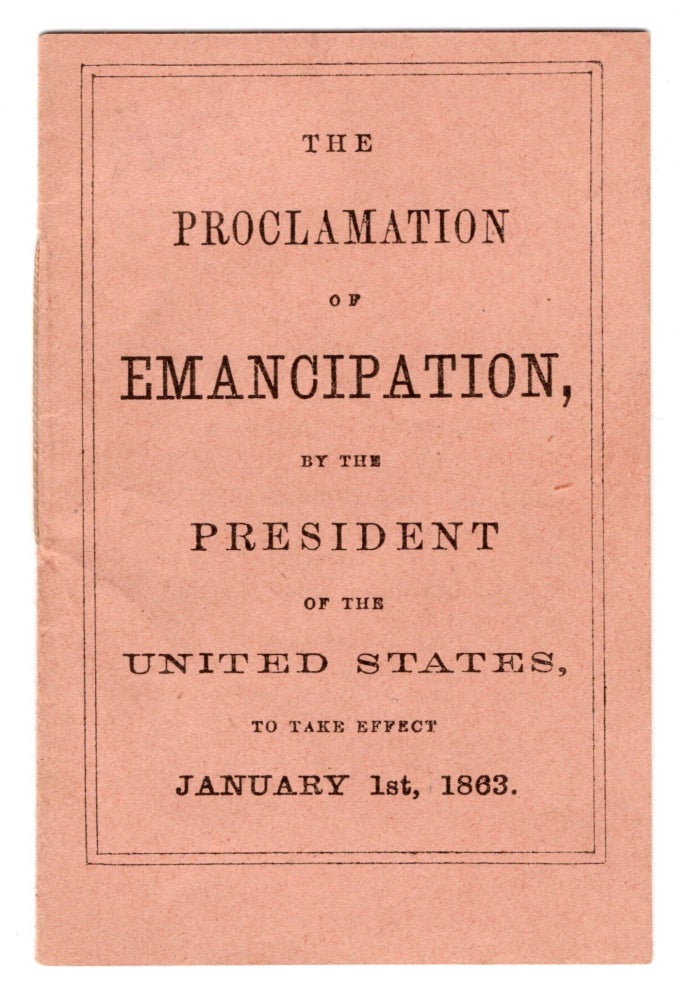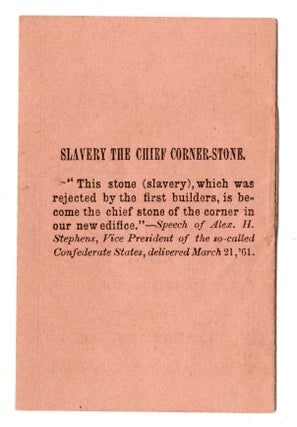The Proclamation of Emancipation by the President of the United States, To Take Effect January 1st, 1863.
[Boston: John Murray Forbes, December, 1862]. 64mo (80mm x 55mm), original printed wrappers. 7 pp. On outside of rear wrapper: “Slavery the chief corner-stone. ‘This stone (slavery,) which was rejected by the first builders, is become the chief stone of the corner in our new edifice.’—Speech of Alex. H. Stephens, vice president of the so-called Confederate States, delivered March 21, ‘61”. CONDITION: Near fine. An extraordinarily well-preserved example of the only pamphlet edition of the preliminary Emancipation Proclamation, the seventh edition overall, published for distribution to soldiers and African Americans. Following the Seven Days Battle and General McLellan’s retreat from the Peninsula, at the end of June, 1862, President Lincoln realized that there would be no early end to the War, and found himself “as inconsolable as it was possible for a human to be and yet live.” Anxious for news from the army and needing to escape the constant interruptions at the White House, he frequently visited the telegraph office in the War Department building to await dispatches. It was during one such visit early in July that he asked the chief of the telegraph staff, Major Thomas Thompson Eckert, for some paper to “write something special,” and began the first draft of the Emancipation Proclamation, completing it in a few weeks. Lincoln had long hoped to resolve the slavery issue through a congressional act of emancipation compensating slave owners for their loss of “property,” but that approach was roundly rejected by representatives from the border states, leaving the President, who had decided upon the necessity of emancipation, with a presidential proclamation as the only option. The extraordinary document he conceived would announce the liberation on the 1st of January, 1863 of all slaves in those states still in rebellion against the Union, and promised compensation to slave owners in those states that returned to the fold before that time if they adopted “immediate or gradual abolishment of slavery.” This proclamation would be followed by a final proclamation issued on the 1st of January, identifying those states still in rebellion and confirming the liberation of all slaves therein. On Tuesday, July 22, Lincoln presented his draft to the Cabinet, telling them that he had resolved firmly upon the course of action it specified, and asking them not for advise but suggestions. The only observation he had not anticipated came from Secretary of State Seward, who proposed that it might be best to wait for a military victory before issuing the Proclamation, as it could otherwise seem like “the last measure of an exhausted government.” Immediately recognizing the wisdom of the suggestion, Lincoln held back. On September 17th, after an anxious wait of nearly two months, he received the victory he needed at the bloody Battle of Antietam. Completing his final draft, Lincoln presented it to his cabinet for refinement on the 22nd of September. Following the meeting, Seward took the amended draft with him to the State Department, where a formal, manuscript copy was made, then signed by Lincoln and Seward. The publisher of this pamphlet edition of the preliminary proclamation, influential Boston business man and philanthropist John Murray Forbes, rendered invaluable assistance to Massachusetts Governor John Andrew during the Civil War. According to the DAB, “He organized the Loyal Publication Society, an effective bureau for propaganda.” The Preliminary Proclamation was evidently one of its publications. In her biography of her father, Sara Forbes Hughes noted “With the view of placing the Proclamation of Emancipation in the hands of the negroes themselves, my father had printed 1,000,000 copies on small slips, one and half inches square, put into packages of fifty each, and distributed among the Northern soldiers at the front, who scattered them about among the blacks, while on the march” (Letters and Recollections of John Murray Forbes). In December of 1862, Forbes wrote to Senator Charles Sumner suggesting the idea, to which Sumner replied “I like much the idea of distributing the Proclamation throughout the army.” Effectively a miniature and rather ephemeral, copies of the pamphlet are scarce today (it seems unlikely that as many as a million copies were printed). Examples as well preserved as the present copy are scarcer still. The first and only pamphlet edition of the Preliminary Proclamation, representing the most vigorous attempt to inform the black population of the particulars of emancipation. REFERENCES: Eberstadt, Lincoln’s Emancipation Proclamation 7, “The only edition of the preliminary proclamation issued in pamphlet form”; Monaghan 147; Hughes, Sara Forbes. Letters and Recollections of John Murray Forbes, pp. 348–9.
Item #7644
Sold



